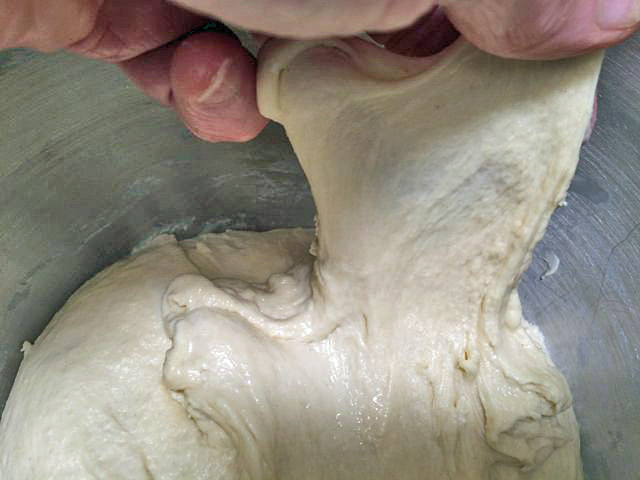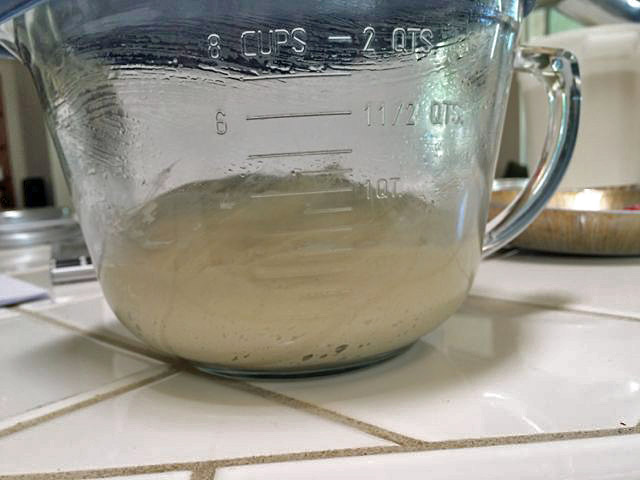Pane Tipo di Altamura
20 April, 2016
David Snyder
This is the latest bake in my series of attempts to produce a good looking and good flavored Pane Tipo di Altamura. I have continued to make modifications based on my experience to date and the experience and resources shared by other TFL members who are also working on this style of bread.
Total Dough | Wt. (g) | Baker's % |
Semola Rimacinata (Fine Durum flour) | 559 | 100 |
Water | 391 | 70 |
Salt | 11 | 1.8 |
Total | 961 | 171.8 |
Lievito Naturale Madre Build 1 | Wt. (g) | Baker's % |
Semola Rimacinata (Fine Durum flour) | 25 | 100 |
Water (80-90ºF) | 17 | 70 |
Semola Rimacinata mother | 10 | 40 |
Total | 52 | 210 |
Place the mother in a medium bowl.
Add the water and mix well.
Add the flour and mix until there is no dry flour and the lievito feels like a bread dough.
Place the dough in a clean bowl and cover tightly.
Ferment for about 8 hours at 77ºF.
Lievito Naturale Madre Build 2 | Wt. (g) | Baker's % |
Semola Rimacinata (Fine Durum flour) | 25 | 100 |
Water (80-90ºF) | 17 | 70 |
Semola Rimacinata lievito madre | 10 | 40 |
Total | 52 | 210 |
Place the mother in a medium bowl.
Add the water and mix well.
Add the flour and mix until there is no dry flour and the lievito feels like a bread dough.
Place the dough in a clean bowl and cover tightly.
Ferment for about 12 hours at 80ºF.
Lievito Naturale Build 3 (Final) | Wt. (g) | Baker's % |
Semola Rimacinata (Fine Durum flour) | 60 | 100 |
Water (80-90ºF) | 42 | 70 |
Semola Rimacinata lievito madre | 12 | 20 |
Total | 114 | 190 |
Place the mother in a medium bowl.
Add the water and mix well.
Add the flour and mix until there is no dry flour and the lievito feels like a bread dough.
Place the dough in a clean bowl and cover tightly.
Ferment for about 6 hours at 77ºF.
Refrigerate overnight.
Final Dough | Wt. (g) |
Semola Rimacinata (Fine Durum flour) | 500 |
Water | 350 |
Salt | 11 |
Lievito Naturale | 100 |
Total | 961 |
Procedures
Mix the Lievito Naturale and water well in the bowl using the paddle. (I used a KitchenAid mixer.)
Add the flour and then the salt. Mix at Speed 1 for 20 minutes. The dough should (nearly) clean the walls of the bowl. It will form a medium windowpane.
Transfer the dough to a lightly oiled bowl. Cover tightly.
Ferment for 90 minutes at 76dF.
Transfer the dough to a lightly floured board and pre-shape as a moderately tight boule.
Cover with a cloth and rest for 30 minutes at 76dF. (I covered the dough with baker's linen and placed it on a quarter sheet tray which fits nicely into my proofing box.)
Pre-heat oven to 500dF with steaming apparatus in place.
Return dough to the board and pre-shape again as a moderately tight boule.
Cover with a cloth and rest for 30 minutes at 76dF.
Return dough to the board.
Using the sides of your two hands, make a wide groove down the middle of the loaf. Dust the top of the loaf lightly with durum flour.Then fold the loaf at the groove so that the upper half over-laps the lower half 3/4 of the way. Do not seal the seam between the upper and lower layers. Rather, seal the fold at the “back” of the loaf.
Transfer the loaf to a peel.
Turn the oven down to 460ºF, steam the oven and transfer the loaf to the baking stone.
Bake with steam for 15 minutes.
Remove the steam source from the oven. Turn the oven temperature down to 435ºF (or 420ºF convection bake).
Bake for another 18-22 minutes. The loaf should be nicely browned. It should sound hollow when the bottom is thumped with a knuckle. The internal temperature should be at least 205ºF.
Transfer the loaf to a cooling rack and cool thoroughly before slicing.
Picture Gallery

Windowpane after mix of 20 minutes at Speed 1

Dough at start of bulk fermentation

Dough after bulk fermentation. Ready for first pre-shaping

After first pre-shaping and 30 minute rest

Baked loaf

A Slice

Crumb close-up
Tasting Notes and comments
I knew this bake was different as soon as I took the bread out of the oven. The aroma was heavenly! It was nutty/wheaty. It was an archetypal “Fresh-baked Bread” aroma. The two previous bakes both had had a yeasty aroma.
The crust was soft, right from when it came out of the oven. (Maybe I really should try not steaming the oven at all.) I left the house to do some errands. When I came home about 3 hours later and got the groceries put away, the loaf was cool, and I cut a slice from the middle.
The crumb was a bit less yellow than my first bake. Maybe this was due to the longer mix, although that was entirely at low speed. Maybe it was the different flour (Central Milling versus KAF). The crust was chewy with a nice nutty flavor. The crumb was pleasantly chewy but not dense-feeling. There was absolutely no sourdough tang, just a remarkably sweet, wheaty flavor that was quite delighful. I ate most of a slice plain, then a bit with some fresh Cotswald cheese. I will have some more with dinner dipped in EVOO and some toasted for breakfast with almond butter.
Clearly, Durum flour obeys a different set of rules than “regular” hard Winter wheat and soft Winter wheat. As mwilson has been saying, the flavor depends on the starter even more than with other flours, and a full fermentation is needed to develop flavor complexity. I am also struck by the absence of acidity. If I fermented my usual mixed flour starter as I did this lievito naturale, the resulting bread would be extremely sour. In fact, perhaps I should try an overnight cold retardation with my next attempt. Before the first pre-shaping? After the final shaping?
The lievito naturale full fermentation also has enormous benefits for dough consistency and, especially, extensibility. This lesson was reinforced greatly by several of the videos of Altamura bakeries at work in which you can really appreciate the expected dough consistency and how it is handled.
At this point, while my loaf shaping still has a lot of room for improvement, the most significant area I want to improve is crust consistency. I have been reluctant to forgo oven steaming for fear of reducing oven spring, but maybe that is what I should try next. A hotter oven is probably worth trying as well.
So, I am very pleased with the improved taste of today's loaf. I still have a lot to work on to get this bread as I believe it should be.
David